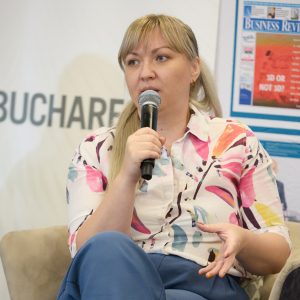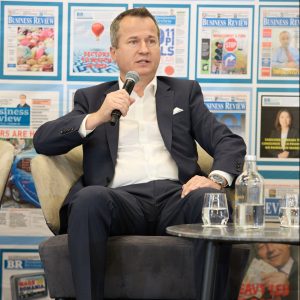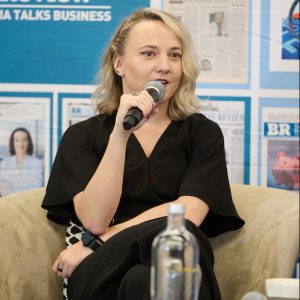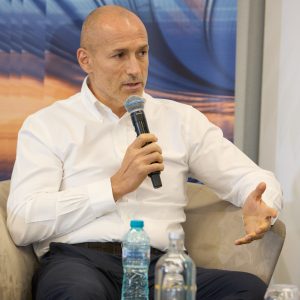In the second panel of Working Romania the guests have delved into the evolving landscape of workplace well-being, employee engagement, and recruitment trends. As organizations adapt to changing work environments and employee expectations, the industry experts share their experiences and strategies for fostering happier, more productive workplaces. From innovative well-being initiatives to the rising importance of ‘quiet hiring’ and the delicate balance between culture fit and culture add, these thought-provoking perspectives offer valuable guidance for both employers and employees navigating the dynamic world of work.
Alina Soare, Head of People Development, EMEA, at Endava: Endava fosters a vibrant ecosystem of communities, each tailored to specific objectives

“In the IT industry, people are at the core of everything we do. In this context, I believe it’s essential to pay great attention to what we offer our employees in terms of both professional and personal development. That’s why the principle we follow in the well-being area is “We Care,” a more comprehensive concept that encompasses several pillars. Among these pillars is the development of our employees, and we focus on the concept of communities. We have technical communities where people can develop their skills, and we also have career coaching communities that provide employees with resources to grow within Endava and in the broader context of their careers. We also have discipline communities where people have access to a multitude of resources to develop beyond their project work. Through these community concepts, we aim to provide more flexibility to our employees.
Regarding the office, we’ve designed it based on neighborhoods. There are specific areas that offer more fluidity, allowing you to move from one community to another, interact with other teams or departments. We place a strong emphasis on the flexibility employees can have in their workplace.
Additionally, we’ve found that it helps to return to the set of values we have as a company. We are all a group of people working together towards a common goal. This helps any organization to be successful. When we went through the pandemic, which involved a rapid shift to remote work, we relied on those values, such as adaptability, that were already part of our organizational culture. These same concepts are helping us today to redefine how we work after a period of entirely remote work. Now, we are seeing a gradual return to hybrid work. This model is taking on a shade of returning to the office, and gradually, we’re having more and more activities and events conducted from the office.”
Antoniu Panait, Managing Director at Vastint Romania: The office building selection process reflects a more holistic approach that accounts for both environmental sustainability and employee well-being.

“We create the foundation and framework in which companies can develop well-being programs and create a pleasant working environment to enhance company performance. Currently, we have two projects in Bucharest, Timpuri Noi Square and Business Garden Bucharest, two large projects that aimed to create state-of-the-art buildings with a small carbon footprint. There have been various certification methods, but ESG is an umbrella that already encompasses all these components. Soon, we’ll all be audited in this regard. Currently, we’re talking about the critical social component. We’ve focused on finding locations close to major residential neighborhoods. This addresses various important aspects, such as reducing extended commuting times. There are many elements we consider, including recycling and the employee experience in buildings. Timpuri Noi was a significant investment and an extraordinary collaboration with the Fratelli Group. We organized “beautiful downtown” for the employees’ experience and the surrounding area. We organize various events such as table football competitions during the pandemic, football competitions, outdoor activities, and we received extraordinary feedback.
Not more than 10 years ago, the decision to relocate or choose an office was made strictly by management based on where they lived or how close it was to the airport. Today, HR departments have a much more significant input. Internal surveys are conducted to understand where employees live and what they need around the office building, including public transportation. The unilateral decision of an individual to choose an office without considering employees’ needs can affect the company financially. Office buildings, the choice of office buildings, and their performance have evolved significantly.”
Mihai Etcu, Talent & Performance Management. Learning & Training Team Leader at Continental Sibiu: Managing such a diverse workforce is a multifaceted challenge, where the aim is to ensure both productivity and employee well-being.

“At Continental Sibiu, we are a hybrid location in terms of how we manage resources and labor force. Specifically, we have a significant research and development center and an equally significant production area. In total, there are over 4,000 employees at the Sibiu location. Managing these 4,000 people presents HR with a challenge of how to keep them both productive and happy. We’re trying to build the Sibiu location in a way that accommodates daily life with professional life. That’s why we’ve implemented a kindergarten that currently supports parents who work at Continental. It consists of 160 children who spend their day just 200 meters away from their parents. Additionally, we have a 24/7 functional canteen and have decided to have a clinic on-site, available to employees whenever they need medical assistance.
We also have a highly productive collaboration with the county school inspectorate and some high schools that understand the value of offering dual education. Currently, we have around 160 students whom we support. They attend a vocational school, learn, and become our colleagues from the first year of study. After three years of study, they officially become our colleagues, hired and contracted, receiving high-quality jobs because during those three years, they learn and we prepare them to program any state-of-the-art technological equipment in the production area.”
Andrada Popescu, Senior Associate, Employment Law Specialist at Noerr: Quiet hiring is increasingly gaining ground in Romania, offering promising advantages for both employers and employees when executed effectively.

“The pandemic significantly changed the labor market, impacting both employees and employers. For employees, there’s a desire for remote work or hybrid work. Many employees are demotivated at the workplace and are experiencing what’s called “quiet quitting.” This means they don’t resign, but they make minimal effort regarding integration and tasks. Among employers, it’s becoming increasingly challenging to find suitable candidates for their positions. They go through arduous recruitment processes that consume time and resources, often without a successful outcome. Furthermore, retention is a challenge for employers who try to keep employees in their organizations. What seems to be a solution is “quiet hiring,” which means attempting to find internal candidates for vacant positions or assigning vacant positions’ responsibilities to internal employees. This is a process that is applied on a large scale, and Google is one of the companies that strongly embraces this process. We’re seeing it more and more in Romania, and it can benefit both employers and employees.
Quiet hiring can be a lasting trend because it offers many benefits when implemented correctly. It reduces costs and time spent on recruitment, allows employers to look at a unique pool of people, avoids direct competition with other employers in the market, and increases employee motivation when you provide opportunities for growth within your organization.”
Alin Popescu, Partner Europe at DHR Global: Amidst the digital revolution, certain timeless elements remain constant and universal in the realm of recruitment

“In general, the differences lie in the tools that a headhunter has at their disposal today. These tools often involve technology and easier communication. However, this wealth of information isn’t always an advantage. A large amount of information needs to be analyzed, verified, and validated, especially in a context where platforms like LinkedIn have only recently started implementing profile and job validation procedures. This leads to increased complexity in recruitment activities and potential pitfalls.
Nevertheless, there will be areas that won’t change and are universal, namely human interaction, the need for trust, and the need for honest communication and understanding the perspective of others. When it comes to retention, it’s the responsibility of both the employee and the employer. You have to want to stay in that organization, and you have to do something in that direction. Those currently in management positions are under tremendous pressure.
More and more, organizations and decision-makers are realizing that a simple ‘culture fit’ isn’t enough. If you focus solely on culture fit, where the person you bring into the organization must have the same set of values and behaviors as those already there, it can lead to excessive uniformity. What’s needed is a combination of ‘culture fit’ and ‘culture add’.”


:quality(80)/business-review.eu/wp-content/uploads/2023/09/Small_NEAN5640.jpg)

:quality(80)/business-review.eu/wp-content/uploads/2024/04/radu-costan-BAT.jpg)



:quality(80)/business-review.eu/wp-content/uploads/2024/06/22C0420_006.jpg)

:quality(80)/business-review.eu/wp-content/uploads/2024/06/COVER-1-4.jpg)



:quality(50)/business-review.eu/wp-content/uploads/2024/04/andreea-voinea-bcr.jpg)
:quality(50)/business-review.eu/wp-content/uploads/2023/05/Andreea-Miron-Stefanini.jpg)
:quality(80)/business-review.eu/wp-content/uploads/2024/06/br-june-2.jpg)
:quality(50)/business-review.eu/wp-content/uploads/2024/07/VGP-Park-Timisoara_-8thbuilding_iulie-24.jpg)
:quality(50)/business-review.eu/wp-content/uploads/2024/07/America-House-Offices-Bucharest-Fortim-Trusted-Advisors.jpg)
:quality(50)/business-review.eu/wp-content/uploads/2024/07/BeFunky-collage-33-scaled.jpg)